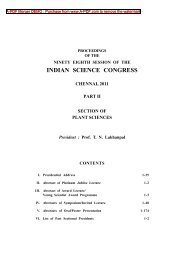sustainable use of biological diversity.pdf - India Environment Portal
sustainable use of biological diversity.pdf - India Environment Portal
sustainable use of biological diversity.pdf - India Environment Portal
Create successful ePaper yourself
Turn your PDF publications into a flip-book with our unique Google optimized e-Paper software.
Sustainable <strong>use</strong> <strong>of</strong> <strong>biological</strong> <strong>diversity</strong> in socio-ecological production landscapes<br />
© Image Bank. Instituto de Tecnologias Educativas.<br />
figure 2. dehesa landscape with holm oaks.<br />
1.6 Threats<br />
A number <strong>of</strong> factors are causing decay in tree density,<br />
coverage and functions in the last decades. One<br />
in particular has a particular environmental character,<br />
the disease termed seca, or sudden die-<strong>of</strong>f <strong>of</strong> the<br />
trees, that has its roots in the stress ca<strong>use</strong>d by the<br />
lengthening <strong>of</strong> the dry season and the opportunistic<br />
invasion <strong>of</strong> a fungus.<br />
Other important factors have an anthropogenic<br />
and historical nature. In periods <strong>of</strong> severe starvation,<br />
particularly in the 1950s, trees were cut and land was<br />
put into cultivation. Later on, the crisis <strong>of</strong> the African<br />
swine fever ca<strong>use</strong>d a dramatic decline <strong>of</strong> the black<br />
Iberian pig livestock –not completely recovered thus<br />
far- and the disruption <strong>of</strong> the pastoral function <strong>of</strong><br />
the dehesa, which ultimately led to transform it to<br />
arable land. The introduction <strong>of</strong> non-native swine<br />
breeds, with a higher productivity, to supply an increasing<br />
demand for meat led to a steep decline <strong>of</strong><br />
the black pig livestock. Also, the partial substitution<br />
<strong>of</strong> cattle for sheep, due to changing market demands,<br />
is increasing grazing pressure in the number <strong>of</strong> units<br />
and duration. The result is a landscape that does not<br />
already hold mixed species and multiple breeds but a<br />
single dominant species, particularly cattle.<br />
And, more importantly, the focus <strong>of</strong> the European<br />
Common Agricultural Policy on productivity and<br />
single crops, and the unawareness <strong>of</strong> the systemic<br />
operation <strong>of</strong> this agrosilvopastoral economy led to<br />
a poor access to financial resources, and to a loss<br />
<strong>of</strong> ability to perform successfully in an agricultural<br />
market dominated by competitiveness and not by<br />
sustainability.<br />
1.7 Local economies<br />
The dehesa historically (at least during the Middle<br />
Ages) exhibits a successful integration <strong>of</strong> a ruralbased<br />
economy with nature conservation and bio<strong>diversity</strong><br />
preservation. Yet multifaceted, the dehesa<br />
essentially aims at extensive livestock production,<br />
so that other activities turn out to be subsidiary or<br />
complementary. Pastoral husbandry is based both<br />
in browsing and grazing. Animals forage by themselves<br />
natural pastures and low vegetation, completing<br />
shrub control, or feed on leaves, s<strong>of</strong>t shoots, and<br />
fruits (oak acorn) such. Thus, shortage <strong>of</strong> fresh fodder<br />
is supplemented with browsing and grazing immature<br />
cereal crops. Every two to five years cropping<br />
is carried out to both provide for forage and control<br />
shrub species invading the herbaceous layer. Yield is<br />
in the range <strong>of</strong> 1200 to 1800 kilograms per hectare<br />
per year, depending on tree coverage.<br />
Silviculture is based on the production <strong>of</strong> firewood,<br />
cork harvesting and the utilization <strong>of</strong> oak acorn for<br />
swine foraging, with yields <strong>of</strong> 200-400 kilograms<br />
per hectare per year, a process that runs from October<br />
until January and known as montanera. Branch<br />
pruning occurs every 10-20 years, and debarking<br />
happens every 9-12 years.<br />
Hunting evolved from a deep-rooted complementary<br />
resource into a key economic activity detached<br />
150
















